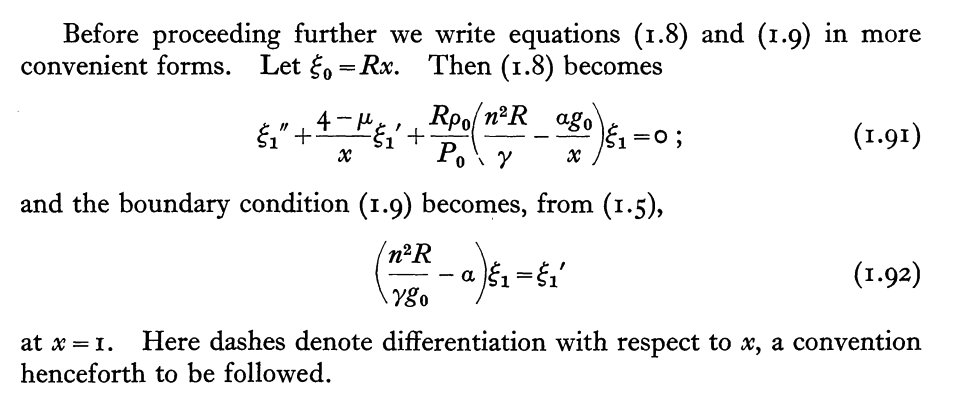User:Tohline/SSC/UniformDensity
The Stability of Uniform-Density Spheres

|
|---|
| | Tiled Menu | Tables of Content | Banner Video | Tohline Home Page | |
The Eigenvalue Problem
Our Approach
As has been derived in an accompanying discussion, the second-order ODE that defines the relevant Eigenvalue problem is,
<math>
\frac{d^2x}{d\chi_0^2} + \biggl[\frac{4}{\chi_0} - \biggl(\frac{\rho_0}{\rho_c}\biggr) \biggl(\frac{P_0}{P_c}\biggr)^{-1} \biggl(\frac{g_0}{g_\mathrm{SSC}}\biggr) \biggr] \frac{dx}{d\chi_0} + \biggl(\frac{\rho_0}{\rho_c}\biggr) \biggl(\frac{P_0}{P_c}\biggr)^{-1} \biggl(\frac{1}{\gamma_\mathrm{g}} \biggr)\biggl[\tau_\mathrm{SSC}^2 \omega^2 + (4 - 3\gamma_\mathrm{g})\biggl(\frac{g_0}{g_\mathrm{SSC}}\biggr) \frac{1}{\chi_0} \biggr] x = 0 .
</math>
where the dimensionless radius,
<math>
\chi_0 \equiv \frac{r_0}{R} ,
</math>
the characteristic time for dynamical oscillations in spherically symmetric configurations (SSC) is,
<math>
\tau_\mathrm{SSC} \equiv \biggl[ \frac{R^2 \rho_c}{P_c} \biggr]^{1/2} ,
</math>
and the characteristic gravitational acceleration is,
<math>
g_\mathrm{SSC} \equiv \frac{P_c}{R \rho_c} .
</math>
The Approach Taken by Sterne (1937)
T. E. Sterne (1937) begins his analysis by deriving the
Adiabatic Wave (or Radial Pulsation) Equation
|
<math>~ \frac{d^2x}{dr_0^2} + \biggl[\frac{4}{r_0} - \biggl(\frac{g_0 \rho_0}{P_0}\biggr) \biggr] \frac{dx}{dr_0} + \biggl(\frac{\rho_0}{\gamma_\mathrm{g} P_0} \biggr)\biggl[\omega^2 + (4 - 3\gamma_\mathrm{g})\frac{g_0}{r_0} \biggr] x = 0 </math> |
in a manner explicitly designed to reproduce Eddington's pulsation equation — it appears as equation (1.8) in Sterne's paper — and, along with it, the surface boundary condition,
|
<math>~ r_0 \frac{d\ln x}{dr_0}</math> |
<math>~=</math> |
<math>~\frac{1}{\gamma_g} \biggl( 4 - 3\gamma_g + \frac{\omega^2 R^3}{GM_\mathrm{tot}}\biggr) </math> at <math>~r_0 = R \, ,</math> |
which appears in Sterne's paper as equation (1.9). Then, as shown in the following paragraph extracted directly from his paper, Sterne (1937) rewrites both of these expressions in, what he considers to be, "more convenient forms."
|
Paragraph extracted from T. E. Sterne (1937)
"Modes of Radial Oscillation"
Monthly Notices of the Royal Astronomical Society, vol. 97, pp. 582 - © Royal Astronomical Society |
||||||||||||||||||||||||
|---|---|---|---|---|---|---|---|---|---|---|---|---|---|---|---|---|---|---|---|---|---|---|---|---|
| ||||||||||||||||||||||||
Properties of the Equilibrium Configuration
Our Setup
From our derived structure of a uniform-density sphere, in terms of the configuration's radius <math>R</math> and mass <math>M</math>, the central pressure and density are, respectively,
<math>P_c = \frac{3G}{8\pi}\biggl( \frac{M^2}{R^4} \biggr) </math> ,
and
<math>\rho_c = \frac{3M}{4\pi R^3} </math> .
Hence the characteristic time and acceleration are, respectively,
<math>
\tau_\mathrm{SSC} = \biggl[ \frac{R^2 \rho_c}{P_c} \biggr]^{1/2} =
\biggl[ \frac{2R^3 }{GM} \biggr]^{1/2} =
\biggl[ \frac{3}{2\pi G\rho_c} \biggr]^{1/2},
</math>
and,
<math>
g_\mathrm{SSC} = \frac{P_c}{R \rho_c} = \biggl( \frac{GM}{2R^2} \biggr) .
</math>
The required functions are,
- Density:
<math>\frac{\rho_0(r_0)}{\rho_c} = 1 </math> ;
- Pressure:
<math>\frac{P_0(r_0)}{P_c} = 1 - \chi_0^2 </math> ;
- Gravitational acceleration:
<math>
\frac{g_0(r_0)}{g_\mathrm{SSC}} = 2\chi_0 .
</math>
So our desired Eigenvalues and Eigenvectors will be solutions to the following ODE:
<math>
\frac{1}{(1 - \chi_0^2)} \biggl\{ (1 - \chi_0^2) \frac{d^2x}{d\chi_0^2} + \frac{4}{\chi_0}\biggl[1 - \frac{3}{2}\chi_0^2 \biggr] \frac{dx}{d\chi_0} + \frac{1}{\gamma_\mathrm{g}} \biggl[\tau_\mathrm{SSC}^2 \omega^2 + 2 (4 - 3\gamma_\mathrm{g}) \biggr] x \biggr\} = 0 .
</math>
Setup as Presented by Sterne (1937)
Analytic Solution
First few lowest-order modes
- Mode 0:
- <math>x_0 = \mathrm{constant}</math>, in which case,
<math> \omega_0^2 = - 2(4 - 3\gamma_\mathrm{g})\biggl[ \frac{2\pi G\rho_c}{3} \biggr] = 4\pi G \rho_c \biggl[ \gamma_\mathrm{g}- \frac{4}{3} \biggr] </math>
- Mode 1:
- <math>x_1 = a + b\chi_0^2</math>, in which case,
<math> \frac{dx}{d\chi_0} = 2b\chi_0; ~~~~ \frac{d^2 x}{d\chi_0^2} = 2b; </math>
<math>
\frac{1}{(1 - \chi_0^2)} \biggl\{ 2b (1 - \chi_0^2) + 8b \biggl[1 - \frac{3}{2}\chi_0^2 \biggr] + A_1 \biggl(1 + \frac{b}{a}\chi_0^2 \biggr) \biggr\} = 0 ,
</math>
where,
<math> A_1 \equiv \frac{a}{\gamma_\mathrm{g}}\biggl[ \biggl( \frac{3}{2\pi G\rho_c} \biggr) \omega_1^2+ 2(4 - 3\gamma_\mathrm{g}) \biggr] . </math>
Therefore,
<math>
(A_1 + 10b) + \biggl[ \biggl(\frac{b}{a}\biggr) A_1 - 14b \biggr] \chi_0^2 = 0 ,
</math>
<math>
\Rightarrow ~~~~~ A_1 = - 10b ~~~~~\mathrm{and} ~~~~~ A_1 = 14a
</math>
<math>
\Rightarrow ~~~~~ \frac{b}{a} = -\frac{7}{5} ~~~~~\mathrm{and} ~~~~~ \frac{A_1}{a} = 14 = \frac{1}{\gamma_\mathrm{g}}\biggl[ \biggl( \frac{3}{2\pi G\rho_c} \biggr) \omega_1^2+ 2(4 - 3\gamma_\mathrm{g}) \biggr] .
</math>
Hence,
<math>
\biggl( \frac{3}{2\pi G\rho_c} \biggr) \omega_1^2 = 20\gamma_\mathrm{g} -8
</math>
<math>
\Rightarrow ~~~~~ \omega_1^2 = \frac{2}{3}\biggl( 4\pi G\rho_c \biggr) (5\gamma_\mathrm{g} -2)
</math>
and, to within an arbitrary normalization factor,
<math> x_1 = 1 - \frac{7}{5}\chi_0^2 . </math>
Sterne's General Solution
n=1 Polytrope
This discussion has been moved to another chapter.

|
|---|
|
© 2014 - 2021 by Joel E. Tohline |
